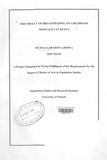| dc.description.abstract | The study assessed the relationship between duration of breastfeeding and infant and
child mortality. The study had three specific objectives. First, to estimate the mean
durations of breastfeeding of children by various maternal background characteristics.
Second, to determine the patterns of survival status of children by the duration of
breastfeeding. Third, to determine the effect to breastfeeding in infant and child mortality
when maternal. Environmental, socio-economic and socio-cultural factors are controlled }
for.
The study was based on data from the 1998 Kenya Demographic and Health survey
(KDHS). A sub sample of 3531 births that occurred to women aged 15-49 years three
years prior to the survey was used for analysis. Out of these births, 256 died between 0-3
years. The analytical framework developed by Mosley and Chen (1984) for child survival
was adopted to guide the study. The variables selected for the study were duration of
breastfeeding, maternal education mother work status, type of place of residence,
ethnicity, parity, maternal age at birth, and type of place of delivery, presence of a toilet
~-.,.,.
/latrine facility and source of drinking water.
The quality of data used was assessed using internal checks by exammmg the age
reporting of the study sample births and deaths as well as assessing age heaping for
births, deaths and breastfeeding data. Incidence-prevalence method was used to calculate
the mean durations of breastfeeding. The mean durations of breastfeeding gave the
patterns and differentials ef breastfeeding by vanous maternal background
characteristics. Childhood mortality differentials according to duration of breastfeeding
are obtained by computing the interval risks of death using life table technique. Bivariate
IV
and Multivariate logistic regression models were run to determine the effect of breast
feeding on infant and child mortality.
Shorter durations of breastfeeding were associated with children borne to more educated,
working younger, parity one, urban mothers. Children borne in health facilities were also
associated with shorter durations of breastfeeding than those borne in non-health
facilities. Interval risks of death revealed that the interval risk of death in infancy (0-11)
months is higher for children breastfed for shorter periods (0-6 months) as compared to
those breastfed for at least 7 months. However, children breastfed for more than 18
months had a higher risk of death was almost the same for all durations of breastfeeding.
This implies ;that child mortality does not vary according to the months a child is
breastfed.
Bivariate logistic regression results indicated that maternal level of education, maternal
work status, place of residence, maternal age at birth, place of delivery, source of
drinking water, presence of toilet facility and ethnicity were statistically significant
factors associated with the risk of infant and child death at 95% confidence level.
Multivariate analysis established that duration of breastfeeding was only significant
parameter estimates of duration of breastfeeding reduced insignificantly as other
independent factors are controlled for.~Thus, the mechanism of causation of the effect of
duration of breast feeding on childhood mortality is not clear.
The study recommended that since the benefits of breastfeeding to the mother and child
are numerous and therefore should be encouraged so as to increase the survival chances
of children. This recommendation is not acceptable before 6 months of age. Efforts
should also be made to achieve high standards of sanitation and health services.
v
Government should enhance policies that ensure universal access to clean water. Since
breastfeeding turned out to be a slightly significant factor in determining infant and child
health, mothers should be educated on alternative hygienic methods of infant and child
feeding and also on nutritious foods that can be given to children with or instead of breast
milk.
NB. Exclusive breastfeeding is most important in the first 6 months and should start
immediately after birth (30 minutes) | en |

